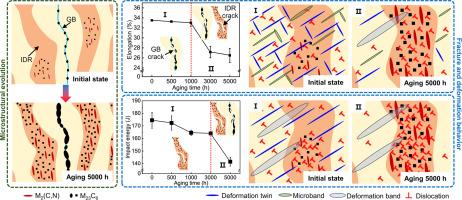550℃时效过程中16Cr-25Ni-4Mo超奥氏体不锈钢焊缝金属的组织与力学性能演变
IF 14.3
1区 材料科学
Q1 MATERIALS SCIENCE, MULTIDISCIPLINARY
引用次数: 0
摘要
研究了16Cr-25Ni-4Mo焊缝金属(WM)在550℃下的长期时效行为,并阐明了沉淀、变形孪晶、微带和变形带如何共同影响其塑性和韧性。时效促进了M23C6碳化物和M2(C, N)碳氮化物的析出。M23C6碳氮化物主要分布在晶界和枝晶间区,而M2(C, N)碳氮化物主要分布在枝晶间区。在GBs下,M23C6碳化物变粗,遵循Lifshitz-Slyozov-Wagner (LSW)模型。时效5000 h时,其平均尺寸达到402.1 nm。在idr中,M23C6碳氮化物表现为多点形核,生长受限,而M2(C, N)碳氮化物则表现为少量形核,生长缓慢。时效5000 h时,M23C6碳氮化物的数量密度和平均尺寸分别为15 μm−2和47.0 nm, M2(C, N)碳氮化物的数量密度和平均尺寸分别为6.0 μm−2和162.5 nm。随着时效时间的延长,WM的塑性和韧性均呈下降趋势,但当GBs和idr同时发生裂纹时,其下降速度更快。拉伸加载过程中,裂纹主要在gb处萌生,并随着时效逐渐强化。在时效3000 h时,由于IDR中析出物的积累形成了额外的IDR裂纹,同时变形孪晶和微带数量的显著减少,共同导致延伸率在1000 - 3000 h之间从33.0%下降到27.2%。相反,冲击裂纹主要起源于IDR,其裂纹严重程度也随着时间的推移而增加。时效5000 h时,由于GBs处M23C6碳化物的粗化和连续分布导致GBs进一步开裂,同时冲击断口附近变形孪晶的消失,导致在3000 ~ 5000 h期间,冲击韧性从164.0 J下降到141.5 J,下降速度更快。本文章由计算机程序翻译,如有差异,请以英文原文为准。

Microstructure and mechanical properties evolution of 16Cr-25Ni-4Mo superaustenitic stainless steel weld metal during 550°C aging
The long-term aging behavior at 550°C was investigated for a 16Cr-25Ni-4Mo weld metal (WM) and to elucidate how precipitation, deformation twins, microbands, and deformation bands jointly affect its plasticity and toughness. Specifically, aging promoted the precipitation of M23C6 carbides and M2(C, N) carbonitrides. M23C6 carbides were distributed along grain boundaries (GBs) and interdendritic regions (IDRs), while M2(C, N) carbonitrides were found only in IDRs. At GBs, M23C6 carbides coarsened, following the Lifshitz-Slyozov-Wagner (LSW) model. At aging 5000 h, their average size reached 402.1 nm. Moreover, their number density peaked at 1.6 μm−2 at aging 1000 h. In the IDRs, M23C6 carbides showed multipoint nucleation with limited growth, whereas M2(C, N) carbonitrides exhibited fewer nucleation with slow growth. At aging 5000 h, the number density and average size of M23C6 carbides were 15 μm−2 and 47.0 nm, respectively, while those of M2(C, N) carbonitrides were 6.0 μm−2 and 162.5 nm, respectively. Both the plasticity and the toughness of the WM deteriorated with increasing aging time, but a more rapid decline occurred when cracks were initiated simultaneously at GBs and in IDRs. During tensile loading, cracks primarily initiated at GBs and gradually intensified with aging. At aging 3000 h, additional IDR cracks formed due to precipitate accumulation in IDRs, together with the marked reduction in the number of deformation twins and microbands, jointly contributed to a faster drop in elongation from 33.0% to 27.2% between 1000 and 3000 h. In contrast, impact cracks mainly originated in the IDRs, where crack severity also increased over time. At aging 5000 h, further GBs cracking induced by coarsened and continuously distributed M23C6 carbides at GBs, together with the disappearance of deformation twins near the impact fracture surface, jointly contributed to a faster drop in impact toughness from 164.0 J to 141.5 J between 3000 and 5000 h.
求助全文
通过发布文献求助,成功后即可免费获取论文全文。
去求助
来源期刊

Journal of Materials Science & Technology
工程技术-材料科学:综合
CiteScore
20.00
自引率
11.00%
发文量
995
审稿时长
13 days
期刊介绍:
Journal of Materials Science & Technology strives to promote global collaboration in the field of materials science and technology. It primarily publishes original research papers, invited review articles, letters, research notes, and summaries of scientific achievements. The journal covers a wide range of materials science and technology topics, including metallic materials, inorganic nonmetallic materials, and composite materials.
 求助内容:
求助内容: 应助结果提醒方式:
应助结果提醒方式:


